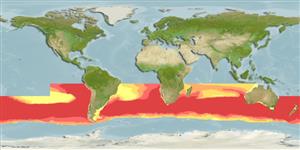>
Scombriformes (Mackerels) >
Scombridae (Mackerels, tunas, bonitos) > Scombrinae
Etymology: Thunnus: Greek, thynnos = tunna (Ref. 45335).
Eponymy: Sir Frederick McCoy (1817–1899) was an Irish paleontologist and naturalist. [...] (Ref. 128868), visit book page.
More on author: Castelnau.
Environment: milieu / climate zone / depth range / distribution range
Ecologia
marinhas; oceanódromo (Ref. 51243); intervalo de profundidade 0 - 2743 m (Ref. 57178). Temperate; 5°C - 20°C (Ref. 168); 10°S - 60°S, 180°W - 180°E (Ref. 54921)
Atlantic, Indian and Pacific: temperate and cold seas, mainly between 30°S and 50°S, to nearly 60°S. During spawning, large fish migrate to tropical seas, off the west coast of Australia, up to 10°S. Highly migratory species. If the current exploitation continues, the population will be below 500 mature individuals in 100 years (Ref. 27905).
Length at first maturity / Tamanho / Peso / Idade
Maturity: Lm 122.0, range 120 - 130 cm
Max length : 245 cm FL macho/indeterminado; (Ref. 5203); common length : 160 cm FL macho/indeterminado; (Ref. 9684); peso máx. Publicado: 260.0 kg (Ref. 5203); Idade máx. registada: 20 anos (Ref. 168)
Vértebras: 39. A very large species, deepest near the middle of the first dorsal fin base. Swim bladder present. Lower sides and belly silvery white with colorless transverse lines alternating with rows of colorless dots. The first dorsal fin is yellow or bluish; the anal fin and finlets are dusky yellow edged with black; the median caudal keel is yellow in adults.
By maturity, most southern bluefin tuna lead an oceanic, pelagic existence (Ref. 6390). Spawning fish and larvae are encountered in waters with surface temperatures between 20° and 30°C. An opportunistic feeder, preying on a wide variety of fishes, crustaceans, cephalopods, salps, and other marine animals. Mostly canned (Ref. 9684). A specialized fishery for sashimi-quality has been developed recently by New Zealand fishers. In Japan, it is highly prized for the sashimi markets.
It is not known whether all mature fish spawn each year, every few years, or even only once in their lifetime (Ref. 30320).
Collette, B.B. and C.E. Nauen, 1983. FAO Species Catalogue. Vol. 2. Scombrids of the world. An annotated and illustrated catalogue of tunas, mackerels, bonitos and related species known to date. Rome: FAO. FAO Fish. Synop. 125(2):137 p. (Ref. 168)
Categoria na Lista Vermelha da IUCN (Ref. 130435: Version 2024-2)
Ameaça para o homem
Harmless
Utilização humana
Pescarias: espécies comerciais; Aquacultura: espécies comerciais; peixe desportivo: sim
Ferramentas
Relatórios especiais
Descarregue XML
Fontes da internet
Estimates based on models
Preferred temperature (Ref.
123201): 2.5 - 7.9, mean 5 °C (based on 439 cells).
Phylogenetic diversity index (Ref.
82804): PD
50 = 0.5039 [Uniqueness, from 0.5 = low to 2.0 = high].
Bayesian length-weight: a=0.01288 (0.01066 - 0.01556), b=3.03 (3.00 - 3.06), in cm total length, based on LWR estimates for this species (Ref.
93245).
Nível Trófico (Ref.
69278): 3.9 ±0.53 se; based on food items.
Resiliência (Ref.
120179): Baixo, tempo mínimo de duplicação da população 4,5 - 14 anos (K=0.14-0.15; tm=8-9; tmax=20; Fec=14 million).
Prior r = 0.27, 95% CL = 0.18 - 0.41, Based on 1 full stock assessment.
Fishing Vulnerability (Ref.
59153): High to very high vulnerability (67 of 100).
Climate Vulnerability (Ref.
125649): Moderate vulnerability (38 of 100).
Nutrients (Ref.
124155): Calcium = 9.89 [5.80, 19.12] mg/100g; Iron = 0.922 [0.355, 2.441] mg/100g; Protein = 23.2 [21.7, 24.6] %; Omega3 = 0.74 [0.44, 1.24] g/100g; Selenium = 31.2 [8.4, 97.4] μg/100g; VitaminA = 22 [3, 199] μg/100g; Zinc = 0.245 [0.131, 0.490] mg/100g (wet weight);
